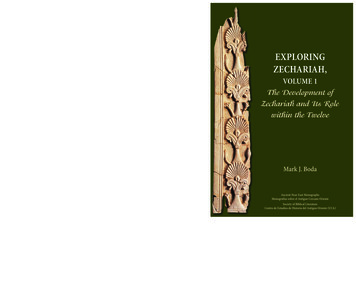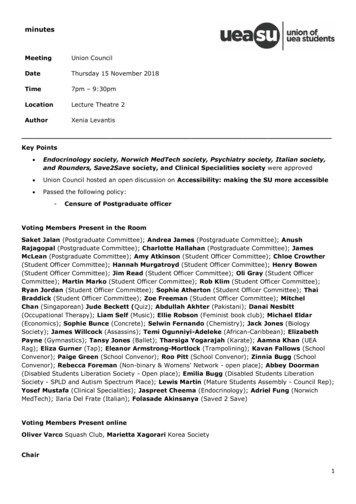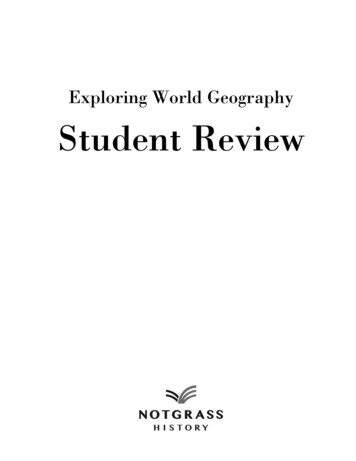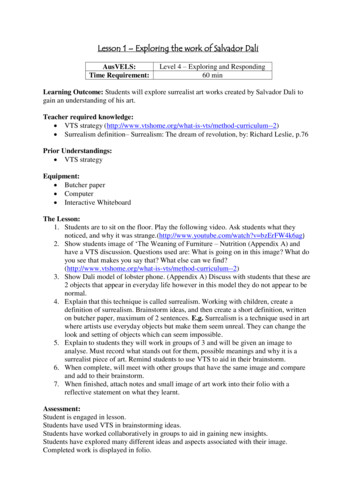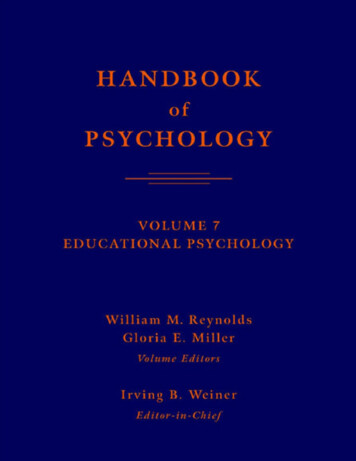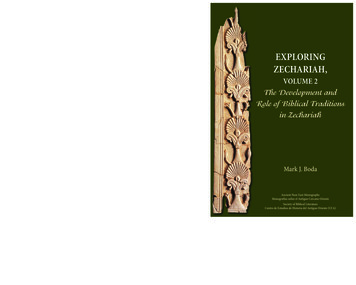
Transcription
MARK J. BODA is Professor of Old Testament at McMaster DivinityCollege. He is the author of ten books, including The Book of Zechariah(Eerdmans) and Haggai and Zechariah Research: A Bibliographic Survey(Deo), and editor of seventeen volumes.EXPLORING ZECHARIAH, VOLUME 2This second volume of Mark J. Boda’s two-volume set on Zechariahshowcases a series of studies tracing the impact of earlier Hebrew Bibletraditions on various passages and sections of the book of Zechariah,including 1:7–6:15; 1:1–6 and 7:1–8:23; and 9:1–14:21. The collection ofthese slightly revised previously published essays leads readers along theargument that Boda has been developing over the past decade.EXPLORINGZECHARIAH,VOLUME 2The Development andRole of Biblical Traditionsin ZechariahAncient Near East MonographsMonografías sobre el Antiguo Cercano OrienteElectronic open access edition (ISBN 978-0-88414-201-0) available athttp://www.sbl-site.org/publications/Books ANEmonographs.aspxCover photo: Zev Radovan/BibleLandPictures.comBodaSociety of Biblical LiteratureCentro de Estudios de Historia del Antiguo Oriente (UCA)Mark J. BodaAncient Near East MonographsMonografías sobre el Antiguo Cercano OrienteSociety of Biblical LiteratureCentro de Estudios de Historia del Antiguo Oriente (UCA)
EXPLORING ZECHARIAH,VOLUME 2
ANCIENT NEAR EAST MONOGRAPHSEditorsAlan LenziJuan Manuel TebesEditorial BoardReinhard AchenbachC. L. CrouchEsther J. HamoriChistopher B. HaysRené KrügerGraciela Gestoso SingerBruce WellsNumber 17
EXPLORING ZECHARIAH,VOLUME 2The Development and Role of BiblicalTraditions in ZechariahbyMark J. Boda
AtlantaCopyright 2017 by SBL PressAll rights reserved. No part of this work may be reproduced or transmitted in any formor by any means, electronic or mechanical, including photocopying and recording, or bymeans of any information storage or retrieval system, except as may be expressly permitted by the 1976 Copyright Act or in writing from the publisher. Requests for permissionshould be addressed in writing to the Rights and Permissions Office, SBL Press, 825 Houston Mill Road, Atlanta, GA 30329 USA.Library of Congress Cataloging in Publication Control Number: 2016961865Printed on acid-free paper.
Ad majorem Dei gloriamFor Michael H. Floyd
ContentsPrefaceixAbbreviationsxiii1.Reading between the Lines: Inner Biblical Allusion and Zechariah2.Terrifying the Horns: Persia and Babylon in Zechariah 1:7–6:15173.Hoy, Hoy: The Prophetic Origins of the Babylonian Tradition inZechariah 2:10–17394.Oil, Crowns, and Thrones: Prophet, Priest, and King in Zechariah1:7–6:15595.Writing the Vision: Zechariah within the Visionary Traditions ofthe Hebrew Bible836.Zechariah: Master Mason or Penitential Prophet?1017.When God’s Voice Breaks Through: Shifts in Revelatory Rhetoric inZechariah 1–81218.Freeing the Burden of Prophecy: משׂא and the Legitimacy ofProphecy in Zechariah 9–141359.Zechariah 11:4–16 in Its Literary Contexts153110. Inner Biblical Allusions in the Shepherd Units of Zechariah 9–1416911. Reading Zechariah 9–14 with the Law and the Prophets:Sibling Rivalry and Prophetic Crisis18312. Afterword197Bibliography199Ancient Sources Index225Modern Authors Index249- vii -
PrefaceDuring the past three decades the book of Zechariah has received increasing attention within the Hebrew Bible guild. This was due no doubt to the appearanceof the influential commentaries of Eric and Carol Meyers as well as David Petersen beginning in the 1980s, but also to the increasing focus on the Persian period in historical and biblical scholarship. Research during this period has beendiverse, focusing on the composition, the structure, and the reception of this ancient text and all points in between. The guild has been witness to a shift fromdominantly diachronic methodologies to a diversity of diachronic, synchronic anda-chronic approaches, reflecting a (con)fusion of modern, postmodern and evenpremodern sensibilities.It was the book of Zechariah that provided me a fresh direction for researchafter spending my doctoral years focusing nearly all my attention on Ezra–Nehemiah. My dissertation on Neh 9 ended by giving attention to connections betweenthat penitential prayer and Zech 7–8. Little did I realize that this conclusion wasmy invitation to two decades of focused attention on this “post-exilic” prophet.Shifting to Zechariah provided me a new challenge to engage deeply with a different genre and tradition (prophetic), but also the opportunity to build on mynewfound knowledge of the Persian period. It was a perfect time to enter into thestudy of Zechariah since there was a growing community of scholars with whomI could converse, dialogue, and debate.During these two decades of work I have written two commentaries and inthe process have sought to test my ideas in the Hebrew Bible scholarly guild. AsI look back I can discern two major streams in my research. On the one hand, Ihave pursued the question of the composition of the book of Zechariah and thelimits of the literary activity related to this prophet and his tradition. On the otherhand, I have continued the line of research that I began in my doctoral work, investigating the presence of inner biblical allusions within Zechariah and the impact of these allusions on the reading of the prophetic book. In the present twovolumes I have brought together several articles that have been published in various literary contexts (journals, collected volumes) or presented at scholarly conferences in which I tested my ideas among learned colleagues. Drawing them together into one collection hopefully will help scholars identify the basis, trace thetrajectory, and engage the conclusions to which I have arrived after two decadesof working with the text of Zechariah.- ix -
xThe Development and Role of Biblical Traditions in ZechariahThis second volume focuses on the phenomenon of inner biblical allusion inthe book of Zechariah,1 a topic to which many had contributed long before I beganmy work and to which many continued to contribute as I have researched over thepast two decades. My interest began with this phenomenon in my doctoral dissertation on Neh 9, but it was Zech 9–14 that seemed to have the most potential forthe use of this method. This soon extended to Zech 1–8. The allusions to otherbiblical materials are plenteous in the book of Zechariah, and I have provided afuller account of this phenomenon in my detailed exegesis in my latest commentary (NICOT). In this present volume I provide some key studies on different sections of Zechariah which bring particular focus onto the role that the Latter Prophets played in Zechariah, with possible connections to the broader Torah andProphets as canonical divisions. As with the first volume, at times I lay a foundation in one chapter and then extend the argument in the next, providing more evidence and teasing out the implications in greater ways. There will be some repetition, but in general each piece is distinct. I have also slightly revised the articlesto fit into their new literary context and where necessary to align them with thelater development in my thought, but most of the material is drawn verbatim frommy earlier works cited at the outset of each chapter.2My personal agenda for gathering scholars together for the sessions and eventually the edited book Bringing Out the Treasure was related to having arrived atZech 9 in researching and writing a commentary and having no idea what to dowith this material. Michael Floyd was gracious enough to join me on this ventureas we drew together key scholars in Europe and North America who had workedor were presently working on Zech 9–14. This reveals how important the academic guild has been to me throughout my career to this point. I have foundamong other scholars a place to test my ideas, but more importantly to learn andbe stretched and to remain accountable for my continued progress. Within thefootnotes of Exploring Zechariah you will find many names of those who haveimpacted my scholarship, whether I agree with their conclusions or not. Thesepeople include both the great cloud of witnesses who have researched and writtenin decades past, but also those who are presently engaged in research. What aprivilege we have to enjoy relationships while pursuing the academic love of ourlives. One particular individual within the guild has been a faithful colleaguealong the way, not only through his superb work in editing now three volumes on1For a similar preface but providing an overview of the first volume, see the preface toExploring Zechariah: Volume 1—The Development of Zechariah and Its Role within theTwelve.2 When a chapter appeared in an earlier Festschrift I have removed specific reference to thehonoree in the body of the text (though noted in the first footnote) so as not to distract fromthe argument. Of course, I mean no disrespect by this and still do fully honor and appreciatethe colleague to which it was dedicated.
Prefacexithe prophets with me, but also through his stellar academic work which has informed my own and spurred me on in my academic pursuits. I dedicate this secondvolume of Exploring Zechariah to Michael Floyd for his faithful service to theguild and in particular his insights into the inner biblical nature of Zechariah.I want to express my thanks to the Society of Biblical Literature ANEM editorial board for accepting these two volumes into their innovative and importantseries. I have appreciated Alan Lenzi for his guidance through the publicationprocess, Nicole Tilford for help with copyediting and layout, and Dustin Burletwith indexing. Thanks especially goes to Alexander C. Stewart, my graduate assistant, who spent considerable time in the initial and final stages adapting thesedisparate essays into a usable form for publication. Much of the research for thearticles within this volume was supported by a generous grant from the CanadianGovernment’s Social Sciences and Humanities Research Council. This grant allowed me to test my ideas at various guild events and support research assistancefor these articles, and for this support I am deeply thankful. Also I want to expressmy thanks to the Senate and Board of McMaster Divinity College for providingthe freedom during a research leave to bring this volume together. Finally, Ideeply appreciate the many publishing houses and journals who have granted mepermission to republish these many essays in slightly revised form in this volume.I have noted the original place of publication at the outset of each essay. Therehave been some revisions to these essays, partly to bring the text into line with theSociety of Biblical Literature ANEM style, but also small corrections and revisions relevant to the new literary place of these articles in this volume. I have keptthese to a minimum. My hope is that this volume will provide some insight intomy approach to the impact of broader biblical traditions on Zechariah and the rolethat Zechariah played in the preservation, explication, and possibly even formation of these broader traditions.Ego ex eorum numero me esse profiteor qui scribunt proficiendo, etscribendo proficient.(Augustine, Epistle 143,2, via Jean Calvin)
or Bible CommentaryAnchor Bible Dictionary. Edited by David Noel Freedman. 6vols. New York: Doubleday, 1992Australian Biblical ReviewAcademia BiblicaAmerican Journal of Semitic Languages and LiteraturesAncient Near East MonographsAlter Orient und Altes TestamentAbhandlungen zur Theologie des Alten und Neuen TestamentsDas Alte Testament DeutschAndrews University Seminary StudiesBonner biblische BeiträgeBibliotheca Ephemeridum Theologicarum LovaniensiumBiblia Hebraica Stuttgartensia. Edited by Karl Elliger andWilhelm Rudolph. Stuttgart: Deutsche Bibelgesellschaft, 1983BiblicaBiblical InterpretationBiblische Studien (Neukirchen, 1951–)Bulletin of the John Rylands University Library of ManchesterBiblical and Judaic Studies from the University of California,San DiegoBiblical ResearchBible TranslatorBeihefte zur Zeitschrift für die alttestamentliche WissenschaftCambridge Bible CommentaryContributions to Biblical Exegesis and TheologyCatholic Biblical QuarterlyContinental CommentariesClassical JournalCanadian Mennonite Bible CollegeColloquiumConiectanea Biblica: Old Testament SeriesConcordia Theological MonthlyCurrents in Biblical Research (formerly Currents in Research:Biblical Studies)Currents in Research: Biblical StudiesDarius I’s Bisitun inscriptionDidaskaliaDeuteronomic- xiii -
xivThe Development and Role of Biblical Traditions in f. es bibliquesEarly Judaism and Its LiteratureEncounterEretz-IsraelEphemerides Theologicae LovaniensesEvangelische TheologieForschungen zum Alten TestamentForms of the Old Testament LiteratureForschungen zur Religion und Literatur des Alten und NeuenTestamentsGesenius’ Hebrew Grammar. Edited by Emil Kautzsch.Translated by Arthur E. Cowley. 2nd ed. Oxford: Clarendon,1910Handbuch zum Alten TestamentHebrew Bible and Ancient IsraelHistorical Commentary on the Old TestamentHeythrop JournalHarvard Semitic MonographsHarvard Theological ReviewHebrew Union College AnnualInterpretation: A Bible Commentary for Teaching andPreachingAn Introduction to Biblical Hebrew Syntax. Bruce K. Waltkeand Michael O’Connor. Winona Lake, IN: Eisenbrauns, 1990Irish Biblical StudiesInternational Critical CommentaryInterpreter’s Dictionary of the Bible: Supplementary Volume.Edited by Keith Crim. Nashville: Abingdon, 1976International Exegetical Commentary on the Old TestamentIsrael Exploration Journalinfinitive constructInterpretationInternational Theological CommentaryInterVarsity PressJournal of the American Oriental SocietyJournal of Biblical LiteratureJournal of the Evangelical Theological SocietyJournal of Hebrew ScripturesJournal of Jewish StudiesJournal of Near Eastern StudiesJoüon, Paul, and Takamitsu Muraoka. A Grammar of Biblical Hebrew.SubBi 14. Rome: Pontifical Biblical Institute, 2000.Jewish Quarterly Review
TSTDJSubBiSymSxvJournal for the Study of Judaism in the Persian, Hellenistic,and Roman PeriodsJournal of the Study of the New TestamentJournal for the Study of the New Testament SupplementSeriesJournal for the Study of the Old TestamentJournal for the Study of the Old Testament Supplement SeriesKommentar zum Alten TestamentKatholisches BibelwerkLectio DivinaThe Library of Hebrew Bible/Old Testament StudiesThe Library of Second Temple StudiesSeptuagint/Old GreekMasoretic TextNew American CommentaryNew Century BibleNeotestamenticaNew International Biblical Commentary on the Old TestamentNew International Commentary on the Old TestamentThe NIV Application CommentaryLa nouvelle revue théologiqueNew Testament Tools and StudiesOribis Biblicus et OrientalisOld Testament GuidesOld Testament LibraryOudtestamentische StudiënProceedings of the Irish Biblical AssociationPoetics and Theory of LiteratureRevue bibliqueSociety of Biblical Literature Dissertation SeriesSociety of Biblical Literature Monograph SeriesSociety of Biblical Literature Seminar PapersStudent Christian Movement PressSmyth & Helwys Bible CommentaryStudies in the History of Religions (supplements to Numen)Scandinavian Journal of the Old TestamentStudia Semitica NeerlandicaStudia TheologicaStudies on the Texts of the Desert of JudahSubsidia BiblicaSymposium Series
xviThe Development and Role of Biblical Traditions in WBCWMANTZAWZWTTheological Lexicon of the Old Testament. Edited by ErnstJenni, with assistance from Claus Westermann. Translated byMark E. Biddle. 3 vols. Peabody, MA: Hendrickson, 1997Tyndale Old Testament CommentariesTranseuphratèneTexte und Untersuchungen zur Geschichte der altchristlichenLiteraturTyndale BulletinUniversity of South Florida International Studies in FormativeChristianity and JudaismVetus TestamentumSupplements to Vetus TestamentumWord Biblical CommentaryWissenschaftliche Monographien zum Alten und NeuenTestamentZeitschrift für die altestamentliche WissenschaftZeitschrift für wissenschaftliche Theologie
1Reading between the Lines:Inner Biblical Allusion and Zechariah1In this initial chapter I provide an overview of my approach and conclusions onthe phenomenon of inner biblical allusion in Zechariah. After tracing the historyof scholarship on this phenomenon in Zechariah, I provide a brief reflection onmethod before summarizing my general conclusions on key biblical influences onZechariah. The chapter concludes with an orientation to the rest of the volume, areference point to see how the more focused studies support key elements withinmy conclusions.The opening pericope of the book of Zechariah (1:1–6) orients the reader to therole that earlier revelation will play in the book as a whole. The speech of Yahwehmakes clear that while the prophets as revelatory conduits have died along withthe rebellious generation they warned (1:5), Yahweh’s revelation through those1This chapter is drawn from earlier work in Mark J. Boda, The Book of Zechariah, NICOT(Grand Rapids: Eerdmans, 2016); Mark J. Boda, Haggai and Zechariah Research: ABibliographic Survey, Tools for Biblical Study 5 (Leiden: Deo, 2003); Mark J. Boda,“Reading between the Lines: Zechariah 11:4–16 in Its Literary Contexts,” in Bringing outthe Treasure: Inner Biblical Allusion and Zechariah 9–14, ed. Mark J. Boda and MichaelH. Floyd, JSOTSup 370 (Sheffield: Sheffield Academic, 2003), 277–91; Mark J. Boda andStanley E. Porter, “Literature to the Third Degree: Prophecy in Zechariah 9–14 and thePassion of Christ,” in Traduire la Bible hébraïque: De la Septante à la Nouvelle BibleSegond Translating the Hebrew Bible: From the Septuagint to the Nouvelle BibleSegond, ed. Robert David and Manuel Jinbachian, Sciences Bibliques 15 (Montreal:Médiaspaul, 2005), 215–54. These sources are combined and revised for inclusion in thisvolume.-1-
2The Development and Role of Biblical Traditions in Zechariahhe called “my servants the prophets” endures (1:6a). That revelation is identifiedas “my words” and “my statutes,” terms which point to both prophecy and law,those revelatory traditions which begin with Moses and endure throughout thehistory of Israel and Judah (see 2 Kgs 17:13). Zechariah 1:4 contains an exampleof the words which endure (“Turn from your evil ways and from your evil deeds”),drawn from the literary tradition of Jeremiah. In similar fashion Zech 7:1–14 alsonotes the words proclaimed through the “earlier prophets” (7:7), echoing againthe words of Jeremiah (7:9–10).In light of this emphasis on earlier revelation preserved in the message ofZechariah, it is not surprising that scholars have consistently highlighted connections between texts in the book of Zechariah and other biblical materials (whetherthrough study of inner biblical allusions or traditio-historical connections). In thelate 1960s and early 1970s four key scholars provided an important foundationfor scholarship on this topic over the past half century. Beuken, Petitjean, andJeremias focused on Zech 1–8,2 while Lutz, Mason, and Willi-Plein attended toZech 9–14.32Wim A. M. Beuken, Haggai–Sacharja 1–8: Studien zur Überlieferungsgeschichte derfrühnachexilischen Prophetie, SSN 10 (Assen: Van Gorcum, 1967); Albert Petitjean, Lesoracles du proto-Zacharie: Un programme de restauration pour la communauté juiveaprès l’exil (Paris: Librairie Lecoffre, 1969); Christian Jeremias, Die Nachtgesichte desSacharja: Untersuchungen zu ihrer Stellung im Zusammenhang der Visionsberichte imAlten Testament und zu ihrem Bildmaterial, FRLANT 117 (Göttingen: Vandehoeck &Ruprecht, 1977); cf. Christian Jeremias, “Sacharja und die prophetische Tradition,untersucht im Zusammenhang der Exodus-, Zion-, und Davidüberlieferung” (PhD diss.,University of Göttingen, 1966).3 Hanns-Martin Lutz, Jahwe, Jerusalem und die Völker: Zur Vorgeschichte von Sach. 12,1–8, und 14, 1–5, WMANT 27 (Neukirchen-Vluyn: Neukirchener, 1968); Rex A. Mason,“The Use of Earlier Biblical Material in Zechariah IX–XIV: A Study in Inner BiblicalExegesis” (PhD diss., University of London, 1973) Rex A. Mason, “The Use of EarlierBiblical Material in Zechariah 9–14: A Study in Inner Biblical Exegesis,” in Bringing outthe Treasure: Inner Biblical Allusion and Zechariah 9–14, ed. Mark J. Boda and MichaelH. Floyd, JSOTSup 370 (Sheffield: Sheffield Academic, 2003), 1–208; Rex A. Mason,“The Relation of Zech 9–14 to Proto-Zechariah,” ZAW 88 (1976): 227–39; Rex A. Mason,“Some Examples of Inner Biblical Exegesis in Zech. IX–XIV,” in Studia Evangelica Vol.7: Papers Presented to the 5th International Congress on Biblical Studies Held at Oxford,1973, ed. Elizabeth A. Livingstone, TUGAL 126 (Berlin: Akademie, 1982), 343–54; RexA. Mason, “Inner Biblical Exegesis in Zech. 9–14,” Grace Theological Journal 3 (1982):51–65; Ina Willi-Plein, Prophetie am Ende: Untersuchungen zu Sacharja 9–14, BBB 42(Köln: Hanstein, 1974). Of course the earlier shorter studies of Bernhard Stade, “Deuterosacharja: Eine kritische Studie I,” ZAW 1 (1881): 1–96; Bernhard Stade, “Deuterosacharja:Eine kritische Studie II,” ZAW 2 (1882): 151–72; Bernhard Stade, “Deuterosacharja: Einekritische Studie III,” ZAW 2 (1882): 275–309; Mathias Delcor, “ Les sources du DeuteroZacharie et ses procédés d’emprunt,” RB 59 (1952): 385–411, created a key platform forMason and Willi-Plein.
Reading between the Lines3Many have followed in the footsteps of these foundational scholars,4 beginning with a flurry of activity in the early 1990s.5 Mason’s student Tollington focused her attention on the first half of the book of Zechariah, noting connectionsbetween Haggai–Zech 1–8 and the pre-exilic prophets through a close examination of continuities and discontinuities in style and tradition.6 In terms of style sheconcluded that these prophets employ similar forms to their classical predecessors(oracles, visions, symbolic action). In terms of tradition, however, she highlightsvarying levels of continuity and discontinuity. As the earlier prophets, Zechariah(and Haggai) drew prophetic authority from a divine calling and revealed similarstruggles for credibility, even if he was more successful than the preexilic prophets in eliciting a response. In contrast to the earlier prophets who attacked thereligious hierarchy of their day, Zechariah (and Haggai) rally the people aroundthe temple and religious identity. Zechariah (and Haggai) approached the leadership tradition in similar ways to the earlier prophets by affirming the Davidic linerepresented by Zerubbabel. However, there are indications in Zech 1–8 (and theframework of Haggai, which is linked by Tollington to Zechariah) that the prophetcame to the conclusion that a diarchic rule of religious and civil leaders wouldsustain the community until the arrival of a Davidic royal. Although there are4Not included in this survey are the helpful contributions from the commentary traditionduring this period, especially from David L. Petersen, Haggai and Zechariah 1–8: ACommentary, OTL (Philadelphia: Westminster, 1984); David L. Petersen, Zechariah 9–14and Malachi: A Commentary, OTL (Louisville: Westminster John Knox, 1995); Carol L.Meyers and Eric M. Meyers, Haggai, Zechariah 1–8: A New Translation with Introductionand Commentary, AB 25B (Garden City, NY: Doubleday, 1987); Carol L. Meyers and EricM. Meyers, Zechariah 9–14: A New Translation with Introduction and Commentary, AB25C (New York: Doubleday, 1993).5 At two junctures during the past fifteen years I along with my colleague Michael Floydhave brought together scholars working on inner biblical allusion/intertextuality, showcasing the results in the following volumes: Mark J. Boda and Michael H. Floyd, eds.,Bringing out the Treasure: Inner Biblical Allusion and Zechariah 9–14, JSOTSup 370(Sheffield: Sheffield Academic, 2003), with articles by Petersen, Floyd, Nurmela, Tigchelaar, Person, Boda, Nogalski, Redditt, Schart, and response from Mason; Mark J. Bodaand Michael H. Floyd, eds., Tradition in Transition: Haggai and Zechariah 1–8 in theTrajectory of Hebrew Theology, LHBOTS 475 (London: T&T Clark, 2008), with articlesby Kessler, Patrick, Redditt, Phinney, Tiemeyer, Wolters, Stead, Boda, Rudman, Floyd,Delkurt, Schnocks, Sweeney, and Pola, and responses from Beuken, Mason, Petersen, andTollington.6 Janet E. Tollington, Tradition and Innovation in Haggai and Zechariah 1–8, JSOTSup150 (Sheffield: JSOT Press, 1993); Janet E. Tollington, “Readings in Haggai: From theProphet to the Completed Book, a Changing Message in Changing Times,” in The Crisisof Israelite Religion: Transformation of Religious Tradition in Exilic and Post-ExilicTimes, ed. Bob Becking and Marjo C. A. Korpel, OtSt 42 (Leiden: Brill, 1999), 194–208.
4The Development and Role of Biblical Traditions in Zechariahmany links to the earlier prophetic tradition regarding Yahweh’s judgment of thepeople, the historical and theological perspective of Zechariah (and Haggai), thatis, that he proclaimed in the Persian period and can declare that the punishmentwas deserved, results in significant differences. Zechariah also considers the future for non-Israelite nations, presenting new hope for these nations as they recognize Yahweh’s sovereignty and join together as the people of God (Haggai focuses more on Israel’s supremacy in the world). Tollington concludes that although Zechariah (and Haggai) was a prophet in the classical tradition, unlike Haggai, he functions somewhat as an innovator who challenged the people to remainopen to a new experience of Yahweh and a different view of the future. Accordingto Tollington in the end the people were unable to grasp his vision and hope.Tollington’s work on Zech 1–8, however, was followed by several key workswhich focused on Zech 9–14. Schaefer restricted his attention to Zech 14 andconcluded that the author composer relied heavily upon earlier sections of Zechariah (chs. 1–13) as well as Jeremiah and Ezekiel.7 Person highlighted many linksbetween Deutero-Zechariah and Deuteronomic literature and concluded that Deutero-Zechariah represents the activity of a Deuteronomic school that continueduntil the time of Ezra.8 These links were established through many lexical connections, but also through similarities in tradition, with special focus on sharedeschatology and common approach to prophecy.9 Larkin was sensitive to innerbiblical connections, even if in the end her focus was on mantological featuresand techniques in Zech 9–14.10 Larkin highlighted exegesis of earlier scripturesdrawn from various parts of the Hebrew Bible (Isaiah, Ezekiel, Amos, Genesis,Psalms, Jeremiah, Hosea, and Deuteronomy), allusions to Proto-Zechariah andtypological connections to Old Testament motifs. Tai analyzed both the traditionand redaction of Zech 9–14.11 He concluded that these chapters were formed infour stages and that each stage reveals a distinct tradition orientation. The firststage (9:1–11:3) drew heavily on the text of Jeremiah not only in its use of theshepherd motif, but also in its announcement of judgment and salvation for Israel7Konrad R. Schaefer, “Zechariah 14 and the Formation of the Book of Zechariah” (SSDdiss., Ecole biblique et archéologique française, 1992); Konrad R. Schaefer, “Zechariah 14and the Composition of the Book of Zechariah,” RB 100 (1993): 368–98; Konrad R.Schaefer, “The Ending of the Book of Zechariah: A Commentary,” RB 100 (1993): 165–238; Konrad R. Schaefer, “Zechariah 14: A Study in Allusion,” CBQ 57 (1995): 66–91.8 Raymond F. Person, Second Zechariah and the Deuteronomic School, JSOTSup 167(Sheffield: JSOT Press, 1993).9 Raymond F. Person, The Deuteronomic School: History, Social Setting, and Literature,SBLMS 2 (Atlanta: Society of Biblical Literature, 2002).10 Katrina J. Larkin, The Eschatology of Second Zechariah: A Study of the Formation of aMantological Wisdom Anthology, CBET 6 (Kampen: Kok, 1994).11 Nicholas Ho Fai Tai, Prophetie als Schriftauslegung in Sacharja 9–14: Traditions- undkompositionsgeschichtliche Studien, Calwer Theologische Monographien 17 (Stuttgart:Calwer, 1996).
Reading between the Lines5and warning against divination. In contrast, the second stage (11:4–16) drew uponthe text of Ezekiel, a trend that was continued into the third stage (12:1–13:9),although there was some evidence of Deuteronomic influence, seen in connections to Hosea, especially in the final pericope (13:1–9). Zechariah 14:1–21 comprises the fourth and final stage and draws on the Day of Yahweh motif in prophetic literature. Tai concluded that Zech 9–14 reveals a new approach to prophecy which entails application of preexisting prophetic texts to new situations. Nurmela also undertook an investigation of similarities between Zechariah and otherOld Testament books.12 He concluded that Zech 9–14 depends mostly on Isaiah(although only chs. 1–11 and 29–31, not 40–55), Jeremiah, and Ezekiel and isinternally dependent upon Zech 1–8.With Delkurt, however, there was a shift back to the first half of Zechariah.Delkurt interpreted Zech 1–6 within the Hebrew prophetic tradition, highlightingrelationships between the night visions and the earlier prophets.13 He concludedthat Zechariah draws on Deutero-Isaiah’s salvation and Zion traditions in order todemonstrate that God is trustworthy. Zechariah also regularly alludes to the bookof Ezekiel. On the one hand he echoes the message of Ezekiel by criticizing culticoutrages (esp. chs. 1–3, 8–11), while on the other, he diverges from his predecessor by
AB Anchor Bible Commentary ABD Anchor Bible Dictionary. Edited by David Noel Freedman. 6 vols. New York: Doubleday, 1992 ABR Australian Biblical Review AcBib Academia Biblica AJSL American Journal of Semitic Languages and Literatures ANEM Ancient N

